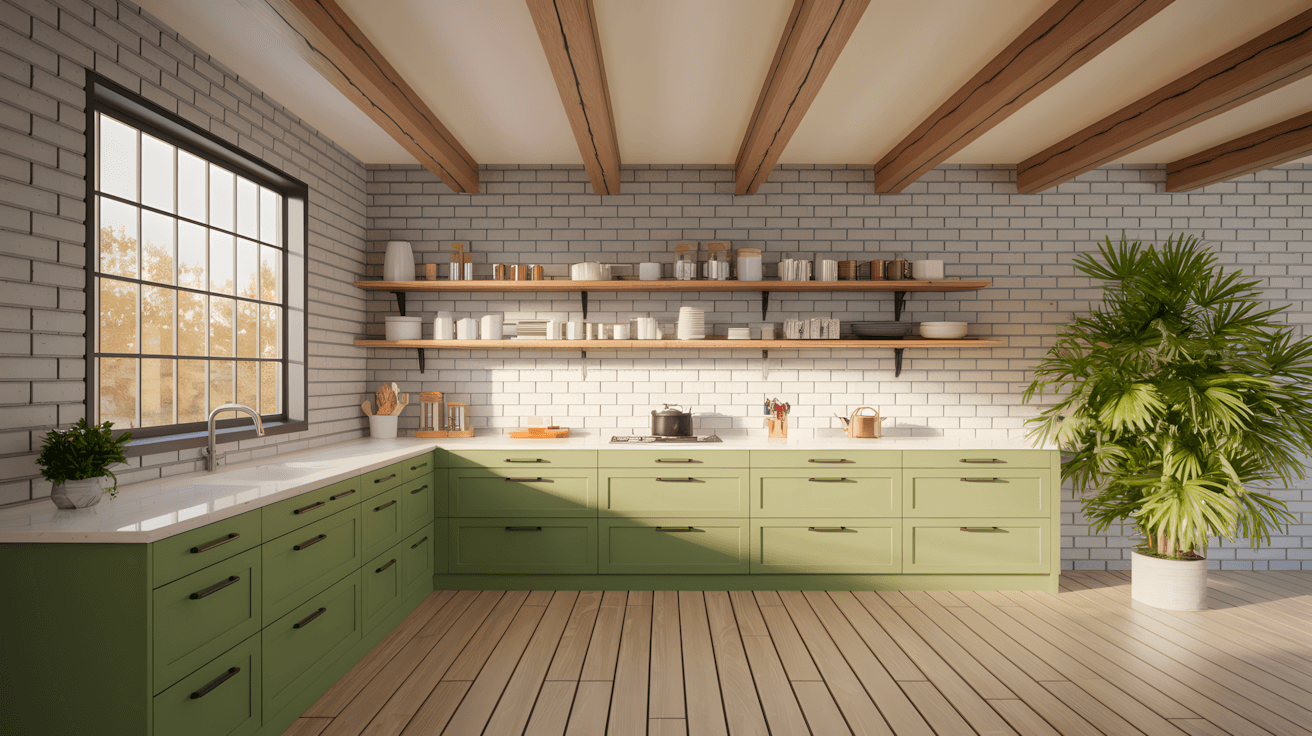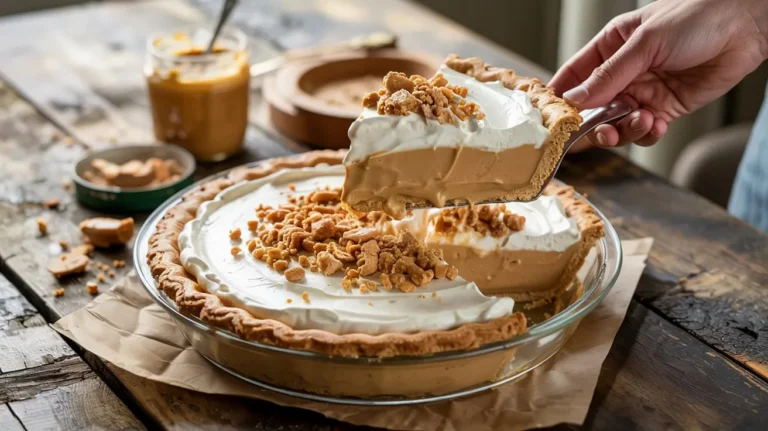After designing kitchen backsplashes for homeowners with varying budgets, cooking habits, and maintenance preferences, I’ve discovered that selecting the right backsplash requires balancing aesthetic appeal with practical performance.
Many stunning backsplashes become regrettable choices when they don’t withstand daily cooking reality.
From my experience working with families on kitchen renovations, I’ve learned which trendy backsplash materials photograph beautifully but become maintenance nightmares, and which time-tested options genuinely enhance both kitchen function and long-term satisfaction.
These 15 backsplash ideas represent solutions that successfully combine visual impact with practical durability.
Understanding Kitchen Backsplash Functionality
A kitchen backsplash serves three essential purposes: protecting walls from moisture, grease, and food splatter; providing easy-to-clean surfaces in high-use areas; and creating visual interest that enhances the kitchen’s overall design.
The most successful backsplashes excel in all three areas while complementing the homeowner’s cooking style and maintenance preferences.
Contemporary Pattern Integration
1. Green Hexagonal Tile Modern Balance

This approach demonstrates how geometric patterns can create visual interest while maintaining practical cleaning ease.
Key Functional Elements:
- Hexagonal tile pattern for grout line minimization – reduces cleaning time while creating contemporary geometric appeal
- Green color choice for stain camouflage – hides minor splatter between deep cleanings better than pure white
- Smooth tile surface for easy maintenance – allows quick daily wipe-downs without texture buildup
- Strategic height placement – covers critical splash zones without unnecessary material waste
Maintenance reality: Hexagonal patterns work well because they minimize grout lines compared to smaller subway tiles, reducing cleaning burden while providing visual interest.
2. Classic Black and Gold Accent Balance

This timeless approach shows how neutral foundations can accommodate bold appliance choices without overwhelming the space.
Key Functional Elements:
- White tile backdrop for universal compatibility – works with changing appliance colors and décor updates
- Simple tile pattern for easy replacement – allows individual tile fixes without pattern matching complications
- Heat-resistant materials behind range – ensures safety and longevity in high-heat cooking zones
- Coordinated wooden elements for warmth – balances cool tile surfaces with natural material comfort
Longevity strategy: Classic white tiles never go out of style and can be updated with different grout colors or accessory changes.
3. Colorful Pattern Statement Integration

This bold approach demonstrates how patterned tiles can work when balanced with neutral surrounding elements.
Key Functional Elements:
- Patterned tiles for visual interest without overwhelming – creates focal point while maintaining kitchen functionality
- White cabinetry balance – prevents pattern overload by providing visual rest areas
- Open shelving for flexible display – allows homeowners to adjust accessories seasonally
- Natural wood flooring for grounding – provides warm foundation that complements various tile patterns
Pattern strategy: Bold backsplash patterns work best when other kitchen elements remain relatively neutral to avoid visual competition.
Full-Coverage Design Applications
4. Floor-to-Ceiling Pattern Extension

This dramatic approach maximizes visual impact while addressing practical coverage needs in active cooking areas.
Key Functional Elements:
- Extended tile coverage for complete protection – eliminates partial splash zones that can develop staining or damage
- Blue and white pattern for timeless appeal – uses colors that remain attractive over time and style changes
- Coordinated countertop selection – ensures tile pattern complements rather than competes with surface materials
- Strategic accent placement – balances pattern intensity with practical cooking functionality
Coverage benefits: Floor-to-ceiling backsplashes eliminate the awkward partial coverage that can collect grease and require touch-up paint.
5. Natural Stone Texture Integration

This earthy approach provides authentic material appeal while addressing the practical needs of active cooking environments.
Key Functional Elements:
- Stacked stone for authentic texture – provides natural variation that hides minor wear and cooking residue
- Gray and beige neutral tones – works with various cabinet colors and future décor changes
- Natural material durability – improves with age rather than showing deterioration
- Varied texture for visual interest – creates depth without requiring pattern maintenance
Natural material advantage: Stone backsplashes often perform better over time than manufactured alternatives, developing character rather than showing wear.
Color and Pattern Coordination
6. Soft Blue Hexagonal Combination

This calming approach demonstrates how color psychology can enhance kitchen comfort while maintaining practical function.
Key Functional Elements:
- Soft blue tones for calming effect – creates peaceful cooking environment while hiding water spots
- White hexagonal tiles for pattern interest – provides geometric appeal without overwhelming small spaces
- Wooden countertop warmth – balances cool tile colors with natural material comfort
- Gold fixture accents – adds warmth without permanent color commitment
Color psychology: Soft blues in kitchens create calming environments that make cooking and cleanup feel less stressful.
7. Hexagonal Farmhouse Elegance

This modern farmhouse approach shows how contemporary patterns can enhance traditional kitchen styles.
Key Functional Elements:
- White hexagonal tiles for classic versatility – provides pattern interest while maintaining farmhouse authenticity
- Dark wooden shelving contrast – creates visual depth while providing functional storage display
- Farmhouse sink integration – maintains style consistency while providing practical workspace
- Black fixture coordination – ties design elements together without overwhelming neutral palette
Style bridge: Hexagonal tiles successfully bridge modern and traditional styles, working in various kitchen aesthetics.
8. Classic Subway Tile Foundation

This enduring approach demonstrates why some backsplash choices remain popular across changing design trends.
Key Functional Elements:
- White subway tiles for universal appeal – provides clean backdrop that works with any kitchen style
- Wooden countertop warmth – adds natural texture that complements cool tile surfaces
- Simple pattern for easy maintenance – allows straightforward cleaning without complex grout patterns
- Timeless proportions – ensures design remains current through style changes
Timeless value: Subway tiles provide excellent return on investment because they appeal to virtually all homebuyers and design preferences.
Bold Statement Integration
9. Geometric Pattern Contemporary Focus

This modern approach shows how bold patterns can serve as kitchen focal points without overwhelming daily functionality.
Key Functional Elements:
- Geometric pattern for contemporary appeal – creates visual interest while maintaining clean, modern aesthetic
- Wooden cabinet coordination – provides warm balance to cool geometric patterns
- Strategic pattern placement – limits bold design to backsplash area to avoid visual overload
- Neutral surrounding elements – allows pattern to be the focal point without competing elements
Pattern placement: Bold backsplash patterns work best when surrounded by neutral elements that don’t compete for visual attention.
10. Rustic Brick Industrial Character
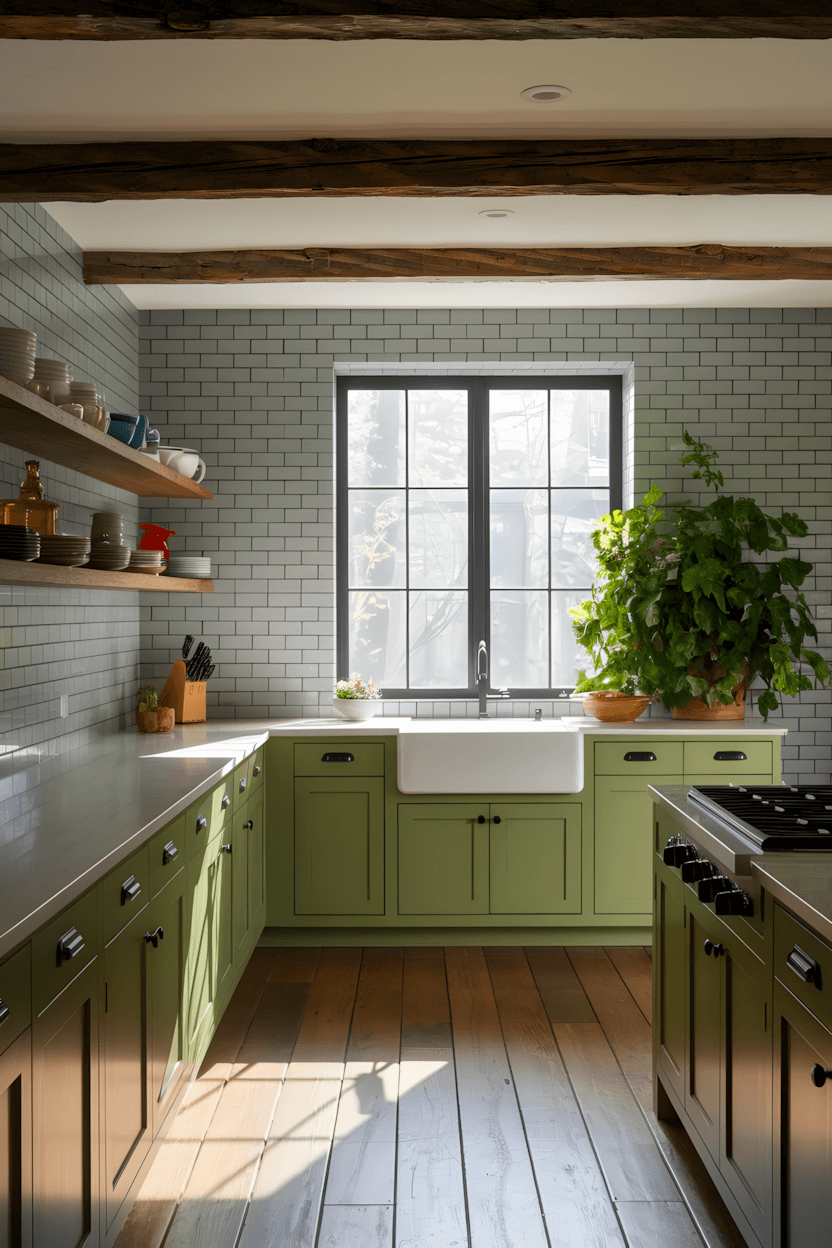
This textural approach demonstrates how industrial elements can enhance kitchen character while providing practical benefits.
Key Functional Elements:
- Light gray brick for authentic texture – provides genuine material character that improves with age
- Green cabinetry for natural color balance – complements brick tones while adding contemporary appeal
- Exposed beam coordination – maintains consistent rustic theme throughout kitchen design
- Natural light optimization – uses windows to highlight material textures attractively
Industrial authenticity: Real brick provides thermal mass benefits and genuine aging characteristics that faux materials cannot match.
Traditional and Vintage Applications
11. Archway Old-World Integration
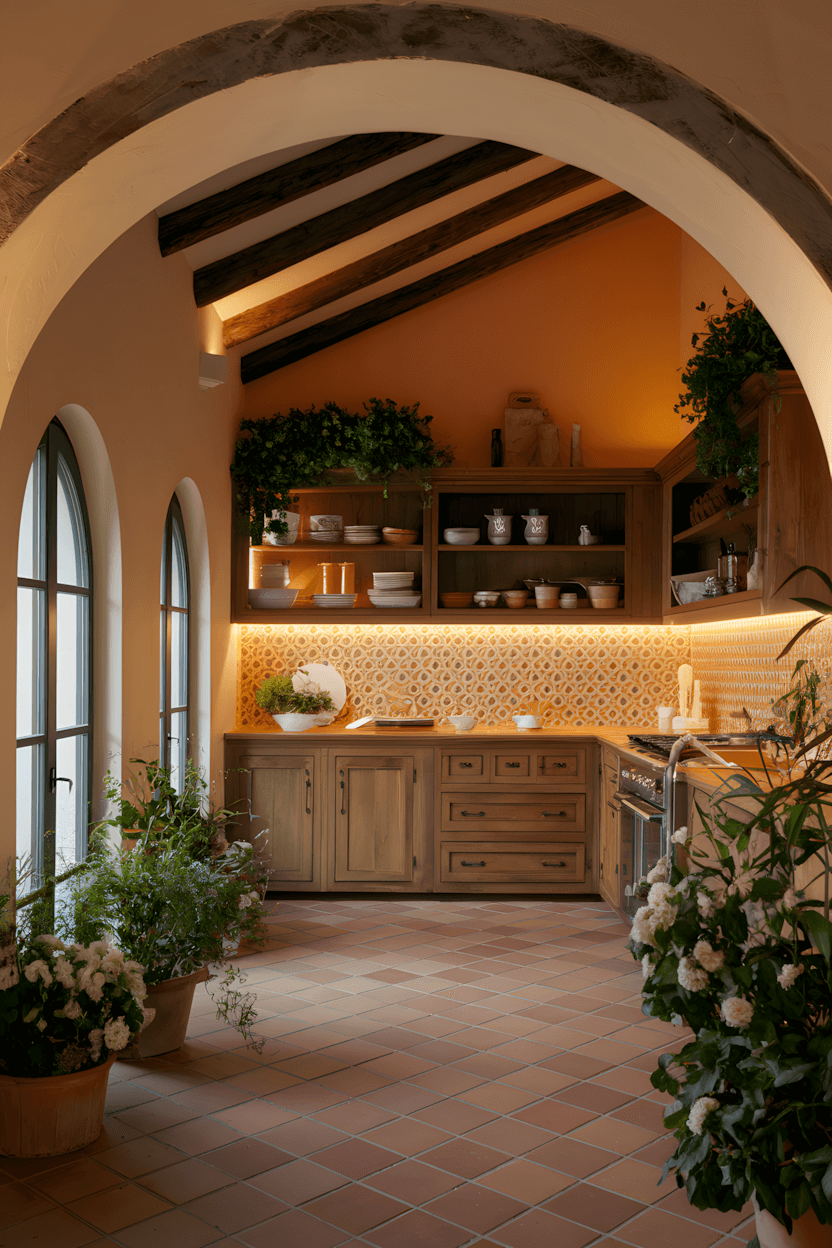
This traditional approach shows how architectural elements can enhance backsplash impact while serving practical functions.
Key Functional Elements:
- Archway framing for architectural interest – creates natural backsplash boundaries while adding character
- Colorful patterned tiles for authentic appeal – uses traditional ceramic artistry for visual richness
- Exposed beam coordination – maintains consistent old-world theme throughout space
- Terracotta flooring complement – coordinates backsplash with other natural materials
Architectural integration: Built-in archways provide natural backsplash frames that eliminate awkward edge transitions.
12. Glossy Green Contemporary Statement
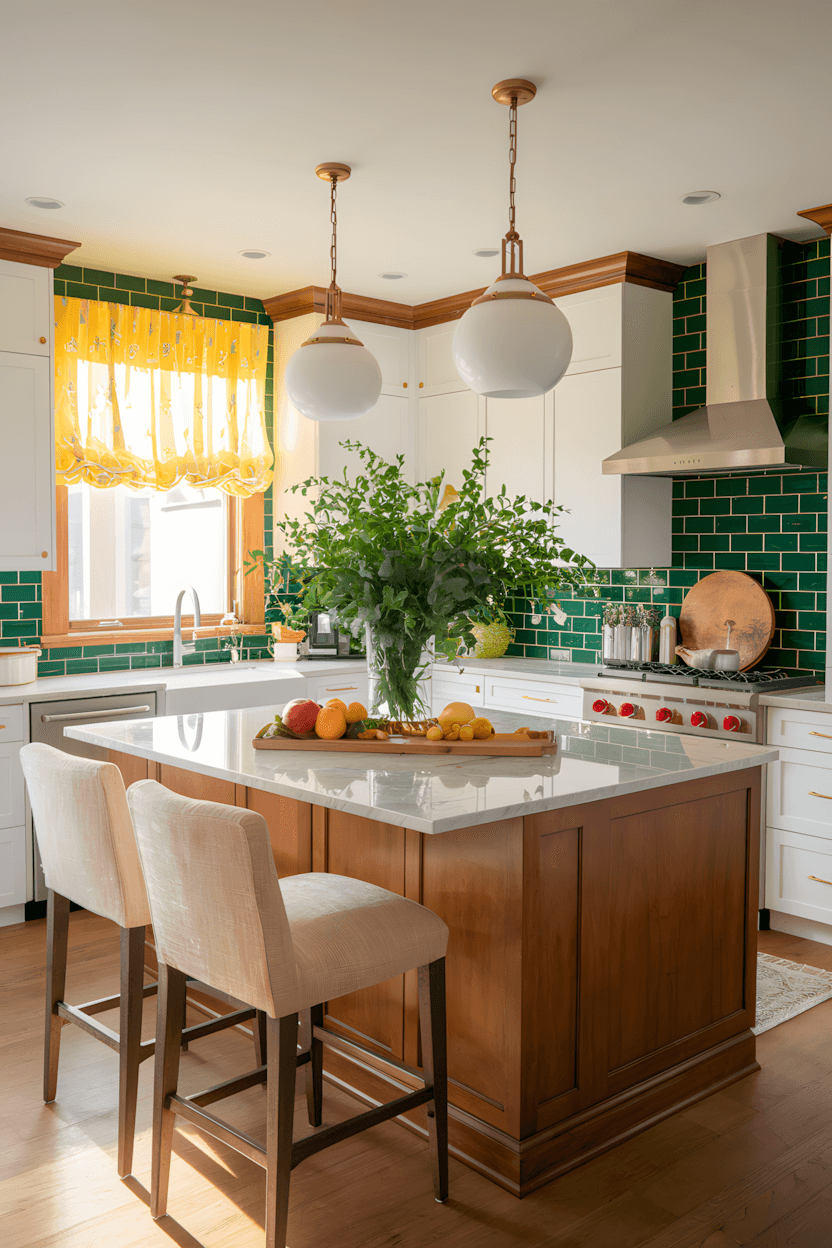
This bold color approach demonstrates how saturated hues can energize kitchen spaces while maintaining sophisticated appeal.
Key Functional Elements:
- Glossy green tiles for easy maintenance – provides smooth surface that cleans easily while making bold statement
- Central island coordination – balances tile color with natural wood tones and neutral surfaces
- Gold accent integration – adds warmth that complements both green tiles and wooden elements
- Natural light enhancement – uses glossy surfaces to reflect and amplify available daylight
Bold color strategy: Intense backsplash colors work best when balanced with neutral countertops and natural materials.
Minimalist and Luxury Approaches
13. Minimalist White Grid Precision
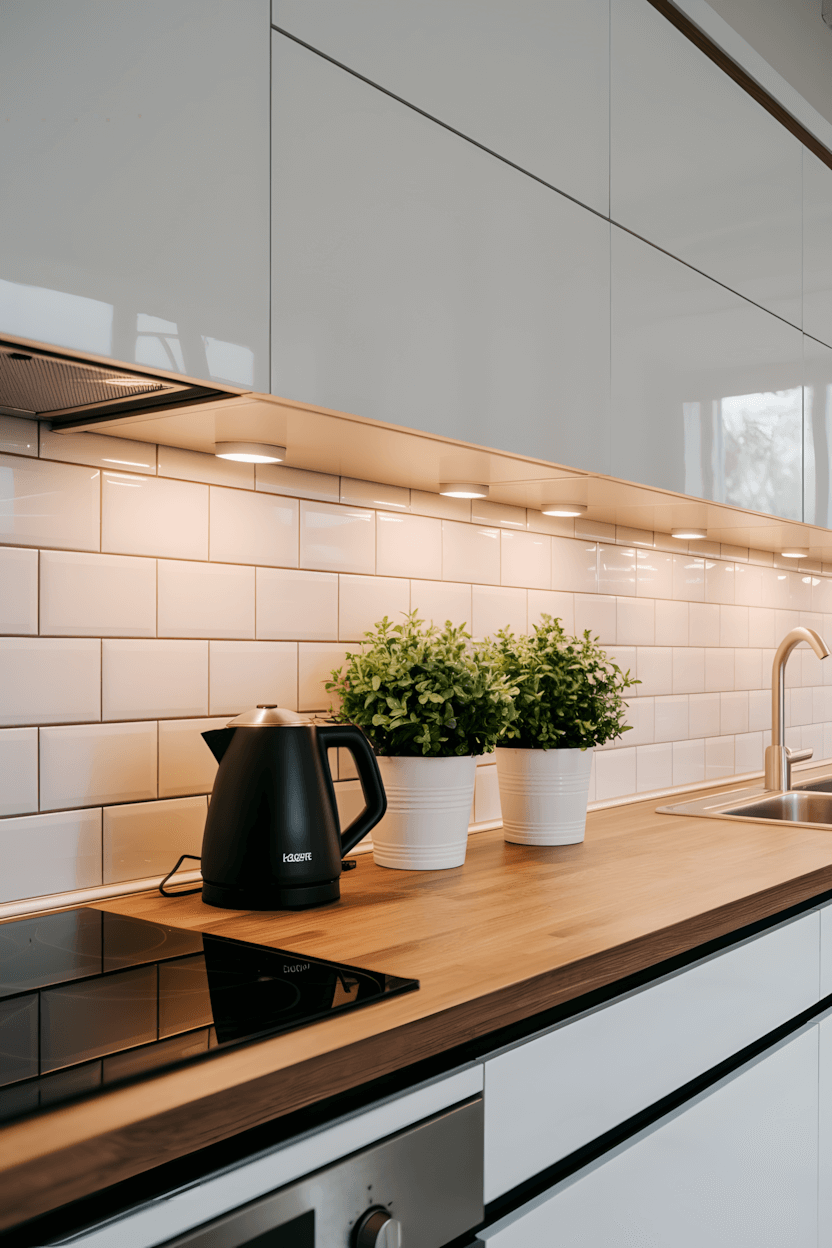
This clean approach demonstrates how simple patterns can create sophisticated impact through quality execution and lighting.
Key Functional Elements:
- White rectangular grid for clean geometry – provides visual interest without pattern complexity
- Under-cabinet lighting enhancement – highlights tile texture and eliminates shadows during food preparation
- Wooden countertop warmth – prevents stark appearance while maintaining minimalist aesthetic
- Strategic accessory placement – uses minimal décor to avoid cluttering clean design
Minimalist success: Simple backsplashes succeed through quality materials and excellent lighting rather than complex patterns.
14. Marble and Gold Luxury Integration
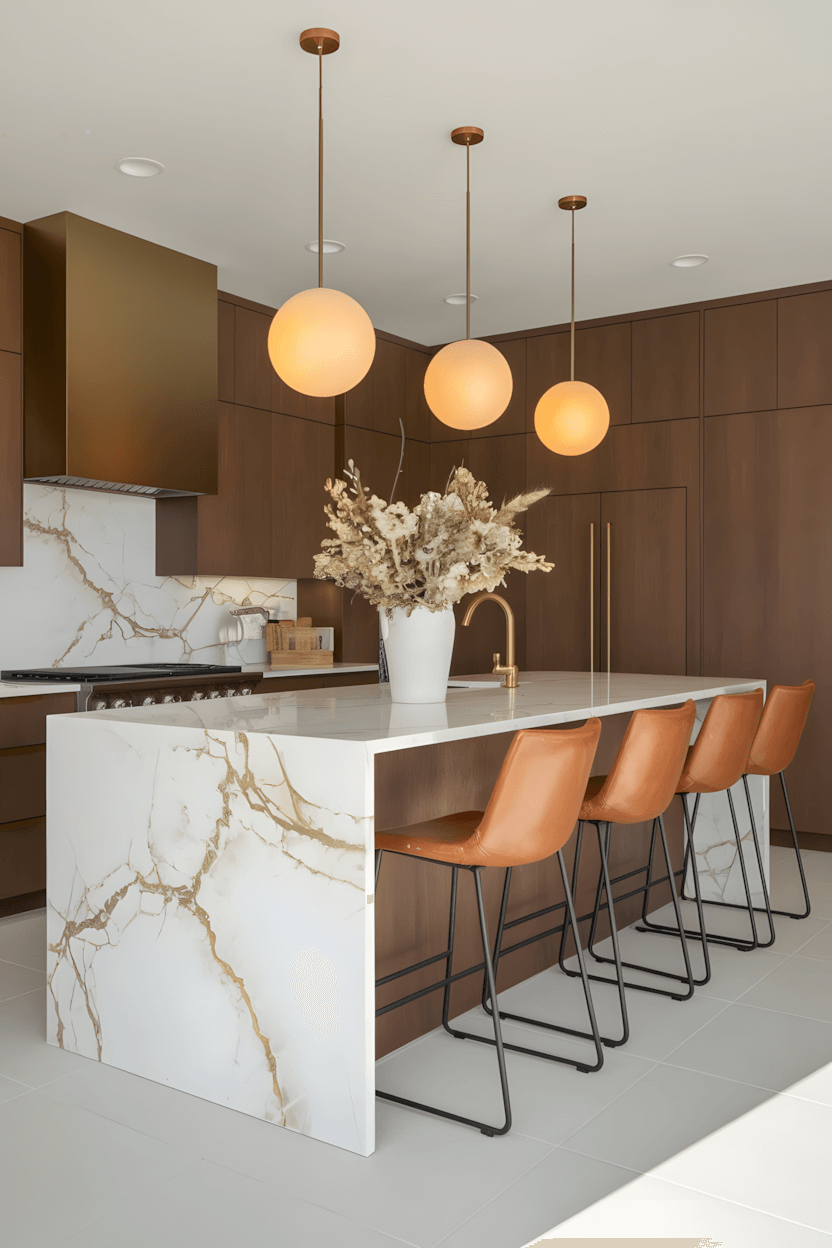
This high-end approach shows how premium materials can create lasting value while providing exceptional functionality.
Key Functional Elements:
- Natural marble for authentic luxury – provides genuine material beauty that improves rather than deteriorates over time
- Gold veining coordination with fixtures – creates cohesive luxury aesthetic through material consistency
- Rich brown cabinetry balance – provides warm contrast that prevents marble from appearing cold
- Quality hardware integration – maintains luxury standard through all design elements
Luxury investment: Premium backsplash materials often provide better long-term value through durability and timeless appeal.
15. Geometric Warm Tone Personality
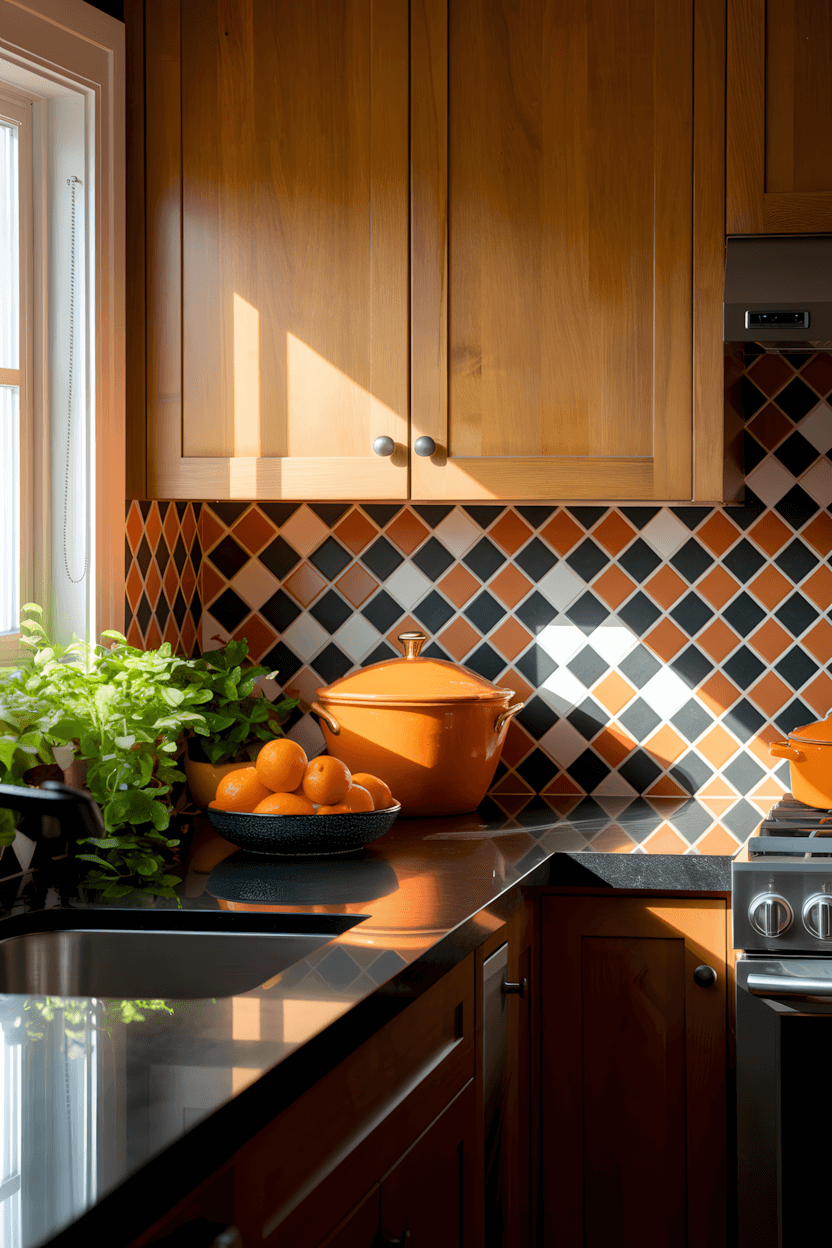
This vibrant approach demonstrates how bold patterns and colors can work in family kitchens when thoughtfully executed.
Key Functional Elements:
- Orange, white, and black geometric pattern – creates energetic focal point while using colors that hide minor stains
- Wooden cabinet and countertop coordination – provides natural balance that grounds bold pattern choices
- Strategic pattern scale – uses appropriately sized geometric elements for kitchen proportions
- Fresh accent integration – incorporates natural elements that complement rather than compete with pattern
Bold pattern success: Vibrant backsplashes work in family kitchens when they incorporate practical colors that camouflage daily cooking reality.
Creating Successful Kitchen Backsplashes
After years of backsplash projects, I’ve learned that successful kitchen backsplashes balance three essential considerations: practical performance for daily cooking and cleaning, aesthetic appeal that enhances rather than overwhelms the kitchen design, and long-term satisfaction that maintains beauty and function over years of use.
The backsplashes that homeowners love long-term are those that solve real daily challenges—easy cleanup, stain resistance, visual appeal—while reflecting their personal style and cooking habits. Focus on understanding your actual kitchen use patterns, maintenance preferences, and design priorities rather than following trends that may not suit your lifestyle.
Most importantly, consider the backsplash as part of the complete kitchen system rather than an isolated design element.
The most successful backsplashes work harmoniously with cabinets, countertops, lighting, and appliances to create cohesive, functional, beautiful kitchens that genuinely support your daily cooking and entertaining needs.
Which of these practical backsplash approaches matches your cooking style, maintenance preferences, and vision for kitchen functionality?

